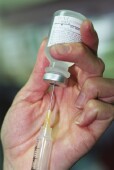- Navigating Your Midlife Crisis: Embracing New Possibilities
- City Raccoons Showing Signs of Domestication
- Mapping the Exposome: Science Broadens Focus to Environmental Disease Triggers
- One Week Less on Social Media Linked to Better Mental Health
- Your Brain Changes in Stages as You Age, Study Finds
- Some Suicide Victims Show No Typical Warning Signs, Study Finds
- ByHeart Formula Faces Lawsuits After Babies Sickened With Botulism
- Switch to Vegan Diet Could Cut Your Greenhouse Gas Emissions in Half
- Regular Bedtime Does Wonders for Blood Pressure
- Dining Alone Could Mean Worse Nutrition for Seniors
Preteen Whooping Cough Vaccine Loses Strength Over Time, CDC Finds


A booster shot of the whooping cough vaccine that is given to preteens loses a large measure of effectiveness within a few years, new research reveals.
The U.S. Centers for Disease Control and Prevention investigation may help explain a recent surge in the number of Americans with whooping cough (pertussis).
“Among adolescents, within the first year following immunization the vaccine effectiveness was 73 percent,” said study author Dr. Anna Acosta, an epidemiologist in the CDC’s division of bacterial diseases. “But by two to four years out, it had fallen to about 34 percent effectiveness.”
Still, Acosta stressed, “we really need to keep in mind that while vaccines are not perfect, they are still the best way to provide protection among children and adolescents.”
In the United States, very young children get a five-dose series of the whooping cough vaccine. A sixth dose of the vaccine has been recommended for adolescents since 2005.
Characterized by severe coughing, whooping cough can impede breathing, cause vomiting and interfere with sleep, the CDC says. Infants face a notably high risk for severe disease and death from whooping cough, Acosta said. The risk of complications for teens and adults is lower but still significant.
Immunizations overall have reduced the rate of whooping cough cases by about 80 percent since the pre-vaccine era, Acosta said.
But vaccine modification may have also contributed to the recent uptick in cases, the researchers said. In 1997, the “accellular pertussis vaccine” for young children replaced the “whole-virus” DTaP vaccine used for the five-dose series.
In 2005, because of concerns about the vaccine’s duration, a sixth dose — called Tdap — was added to the vaccine protocol, specifically for kids aged 11 and 12 and adults who never got Tdap. (The combination vaccine also protects against tetanus and diphtheria).
Even with high childhood and preteen vaccine coverage, the United States experienced about 48,000 cases of whooping cough in 2012 — the most since 1955, according to the CDC.
Scientists began wondering if waning immunity — a known issue for the old vaccine — also plagues the new series.
To answer that concern, the study team zeroed in on a pertussis epidemic in Washington state in 2012. Five thousand people came down with whooping cough, many of them in their early teens, despite the state’s 86 percent Tdap coverage rate.
Focus was placed on about 1,700 teens born between 1993 and 2000 — kids who would have received the newer vaccine. This group experienced 450 cases of whooping cough.
Overall, Tdap effectiveness for this group was pegged at about 64 percent, but that plummeted to 34 percent two to four years post-inoculation, the investigators found.
Similar findings emerged from a Wisconsin study, leading the CDC to attribute the recent spike in whooping cough to a waning of Tdap effectiveness.
Going forward, CDC investigators said two things are needed: a better understanding of how exactly the pertussis bacteria works and an improved vaccine. But for the time being they don’t recommend any shift in vaccine protocols.
Acosta stressed that expectant mothers should continue to get inoculated against whooping cough during their third trimester. Maternal inoculation “will protect the infant until they are able to receive their own doses at 2, 4, and 6 months of age,” she said.
Another reason to get vaccinated, Acosta said, is that if an immunized person does become sick, the disease will be less severe.
Dr. Paul Offit, chief of infectious diseases at Children’s Hospital of Philadelphia, expressed little surprise at the notion that Tdap effectiveness wanes with time.
However, “you’re still better off getting the vaccine than not,” he said.
“I think the path forward is to get a better vaccine,” Offit added, “and people are working on that.”
The study findings are published online May 4 in the journal Pediatrics.
More information
There’s more on whooping cough at the U.S. Centers for Disease Control and Prevention.
Source: HealthDay
Copyright © 2025 HealthDay. All rights reserved.










